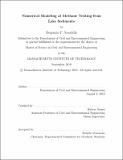| dc.contributor.advisor | Ruben Juanes. | en_US |
| dc.contributor.author | Scandella, Benjamin P. (Benjamin Paul) | en_US |
| dc.contributor.other | Massachusetts Institute of Technology. Dept. of Civil and Environmental Engineering. | en_US |
| dc.date.accessioned | 2011-04-04T17:37:37Z | |
| dc.date.available | 2011-04-04T17:37:37Z | |
| dc.date.copyright | 2010 | en_US |
| dc.date.issued | 2010 | en_US |
| dc.identifier.uri | http://hdl.handle.net/1721.1/62088 | |
| dc.description | Thesis (S.M.)--Massachusetts Institute of Technology, Dept. of Civil and Environmental Engineering, 2010. | en_US |
| dc.description | This electronic version was submitted by the student author. The certified thesis is available in the Institute Archives and Special Collections. | en_US |
| dc.description | Cataloged from student-submitted PDF version of thesis. | en_US |
| dc.description | Includes bibliographical references (p. 91-96). | en_US |
| dc.description.abstract | The dynamics of methane transport in lake sediments control the release of methane into the water column above, and the portion that reaches the atmosphere may contribute significantly to the greenhouse effect. The observed dynamics are poorly understood. In particular, variations in the hydrostatic load on the sediments, from both water level and barometric pressure, appear to trigger free gas bubbling (ebullition). We develop a model of methane bubble ow through the sediments, forced by changes in hydrostatic load. The mechanistic, numerical model is tuned to and compared against ebullition data from Upper Mystic Lake, MA, and the predictions match the daily temporal character of the observed gas releases. We conclude that the combination of plastic gas cavity deformation and ow through "breathing" gas conduits explains methane venting from lake sediments. This research lays the groundwork for integrated modeling of methane transport in the sediment and water column to constrain the atmospheric flux from methane-generating lakes. | en_US |
| dc.description.statementofresponsibility | by Benjamin P. Scandella. | en_US |
| dc.format.extent | 96 p. | en_US |
| dc.language.iso | eng | en_US |
| dc.publisher | Massachusetts Institute of Technology | en_US |
| dc.rights | M.I.T. theses are protected by
copyright. They may be viewed from this source for any purpose, but
reproduction or distribution in any format is prohibited without written
permission. See provided URL for inquiries about permission. | en_US |
| dc.rights.uri | http://dspace.mit.edu/handle/1721.1/7582 | en_US |
| dc.subject | Civil and Environmental Engineering. | en_US |
| dc.title | Numerical modeling of methane venting from lake sediments | en_US |
| dc.type | Thesis | en_US |
| dc.description.degree | S.M. | en_US |
| dc.contributor.department | Massachusetts Institute of Technology. Department of Civil and Environmental Engineering | en_US |
| dc.identifier.oclc | 707640117 | en_US |
